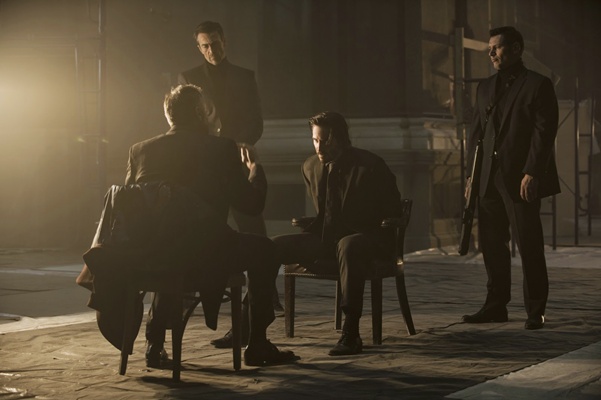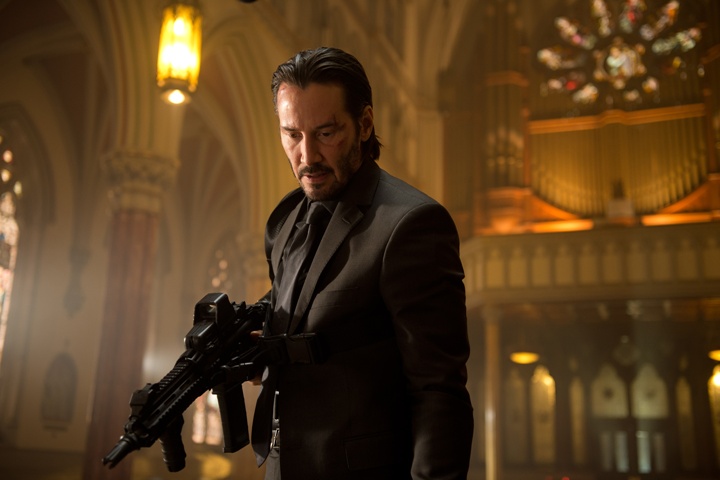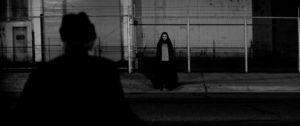If you can’t deal with a film built around a man taking revenge against the thugs that killed his dog, then this is clearly not for you. For everyone else, rejoice for we now have a film where Keanu Reeves walks into a church and starts shooting.
John Wick (Keanu Reeves) is a reformed hitman who has been living the quiet life with his wife Helen (Bridget Moynahan). An illness causes her to pass away, but to make sure John isn’t alone she leaves him a dog, Daisy. When giving Daisy a ride in his ‘69 Mustang Mach 1, John encounters some Russian gangsters led by Iosef (Alfie Allen), who take an interest in John’s car. Later they break into John’s home, beat him up, kill his dog and steal his Mustang. John does not take this lightly. He puts on his best suit, loads up on weapons and manages to hunt down those responsible to New York. John discovers that Iosef is the son of his former boss, Viggo (Michael Nyqvist) and turns the city into his bullet-ridden playground trying to track him down.
From stuntman turned director, Chad Stahelski (who was Reeves stunt double in films such as The Matrix and Constantine), John Wick is his directorial debut. Stunt collaborator David Leitch is credited as a producer. Given his background, Stahelski excels here when it comes to framing the action itself. John takes down wave after wave of nameless bad guys and does this as stylishly as possible, with moments of balletic gunplay that pays homage to the likes of John Woo’s A Better Tomorrow and The Killer. There’s none of that shakey camera nonsense and multiple edits to hide inexperience (the Taken franchise being a notable culprit). Stahelski (along with cinematographer Jonathan Sela) wants the audience to appreciate the action here, to show that John really is good at shooting people (mostly in the head), and the camera does not shy away from the violence.
 The film builds John up as a legendary hitman, and it does this ridiculously well. “I once saw him kill three men in a bar with a pencil,” remarks former boss Viggo (Michael Nyqvist making the most of a standard villain). When we first see John in action, he kills about 12 men within the space of three minutes. Almost everyone John meets long enough to have a conversation with knows of his reputation.
The film builds John up as a legendary hitman, and it does this ridiculously well. “I once saw him kill three men in a bar with a pencil,” remarks former boss Viggo (Michael Nyqvist making the most of a standard villain). When we first see John in action, he kills about 12 men within the space of three minutes. Almost everyone John meets long enough to have a conversation with knows of his reputation.
The number of bodies and mayhem John leaves in his wake during his time in New York would obviously attract the attention of the police, yet the one and only appearance by a police officer tells us that they’re willing to turn a blind eye to whatever he does. This is a necessary inclusion, for Stahelski understands that adding extra sirens and cops to the mix would only ruin the pace.
Stahelski also doesn’t want you to forget why John is taking revenge, with a few reminders where we hear that it was, “just a dog”. The fact that Reeves plays this seriously merely strengthens the film. Seeing John tear through New York appears to be an indirect way of dealing with the loss of his wife. When she is struck with an illness, John is completely helpless. He cites the dog she left behind as all that remained of his wife’s memory. So when that is taken from him too, this time there is at least someone responsible, something he can do about it, and you’re rooting for him all the way.
Reeves’ character is made out to be a one-man army, and his past action roles in films such as The Matrix trilogy, Speed and even the recent Man of Tai Chi adds to the belief of what John is capable of. Yet there are also moments where Reeves convinces as a vulnerable anti-hero. Yes, there is a cringeworthy teary moment, but he is beaten up, thrown, shot, stabbed and a few of his adversaries even take advantage of his injuries. Even though he’s patched up, it’s interesting to see that the injuries affect his skills as the film progresses.
Derek Kolstad’s screenplay borders upon the generic and is fairly predictable (a clichéd duel in the rain is a bit of a letdown), but John Wick doesn’t pretend to be anything more than what it is. As well as paying homage to revenge movies like Point Blank and Man on Fire, there is a clear video game structure to the plot, as John takes down numerous henchmen and uses up all of his lives taking out fellow assassins to reach the final boss. As a wink to a certain generation, the film even shows someone playing a first-person shooter.
It’s impressive to see just how much personality the supporting actors bring to their characters. As fellow assassins Marcus (Willem Dafoe), Harry (Clarke Peters) and Perkins (Adrianne Palicki), the actors make the most of their screentime and could potentially have a movie that centres around them. Ian McShane and Lance Reddick appear as a manager and receptionist respectively of the Continental Hotel, which John stays in. Despite being on screen for a matter of minutes, both leave a lasting impression. Crucial to the story, the hotel itself runs as a safe haven for assassins with strict rules. Anyone who breaks the rules suffers heavy consequences.
 The eccentric soundtrack features a musical score by Tyler Bates and Joel J. Richard. Expected dance tracks with a heavy bass line are also there alongside the action, compliments of Le Castle Vania. During John’s shootout at a club sauna, we hear KALEIDA’s Think, a light synth-pop tune that initially seems to go against what we’re seeing. Yet when John locks eyes with his nemesis with this track playing in the background, the scene is elevated into something truly majestic, highlighting John’s sheer determination.
The eccentric soundtrack features a musical score by Tyler Bates and Joel J. Richard. Expected dance tracks with a heavy bass line are also there alongside the action, compliments of Le Castle Vania. During John’s shootout at a club sauna, we hear KALEIDA’s Think, a light synth-pop tune that initially seems to go against what we’re seeing. Yet when John locks eyes with his nemesis with this track playing in the background, the scene is elevated into something truly majestic, highlighting John’s sheer determination.
While John Wick walks a predictable path, Stahelski’s directorial debut injects the typical revenge scenario with an insane premise and inventive action sequences, executed with real passion. Slick, gritty and gloriously entertaining, it’s up there with Kingsman: The Secret Service as one of the coolest action films of the year. It’s no surprise that a sequel is already in the works.
John Wick opens in UK cinemas on 10 April 2015.
Originally published on MCM Buzz on 1 April 2015.



